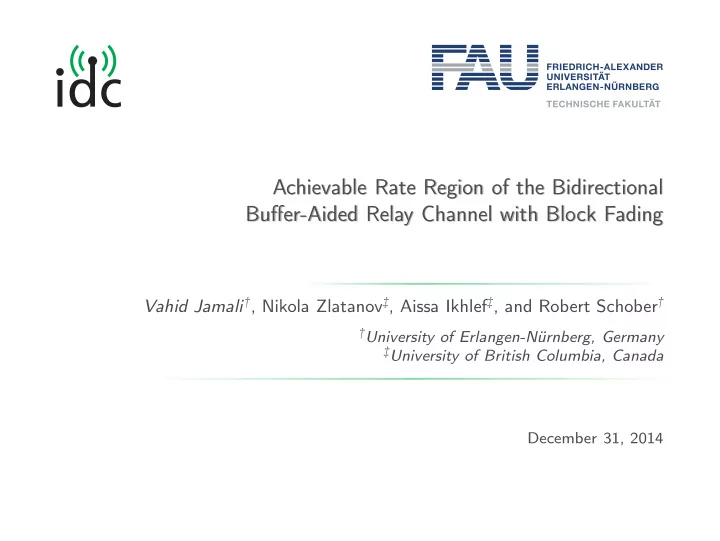

Achievable Rate Region of the Bidirectional Achievable Rate Region of the Bidirectional Buffer-Aided Relay Channel with Block Fading Buffer-Aided Relay Channel with Block Fading Vahid Jamali † , Nikola Zlatanov ‡ , Aissa Ikhlef ‡ , and Robert Schober † † University of Erlangen-Nürnberg, Germany ‡ University of British Columbia, Canada December 31, 2014
System Model System Model We consider a simple network in which user 1 and 2 exchange in- formation with the help of a relay node: h 1 ( i ) Z r ( i ) h 2 ( i ) Relay Y r ( i ) User 1 User 2 Decoder W 12 ( i ) Encoder Encoder W 21 ( i ) B 2 X 1 ( i ) B 1 X 2 ( i ) � W 12 ( i ) � W 21 ( i ) � � � � W 12 ( i ) W 12 ( i ) Y 1 ( i ) Y 2 ( i ) � � W 21 ( i ) Decoder Decoder W 12 ( i ) Encoder Z 1 ( i ) h 1 ( i ) Z 2 ( i ) h 2 ( i ) X r ( i ) Half-duplex constraint for the nodes. Channels are reciprocal and block fading. The relay is equipped with buffers B 1 and B 2 Vahid Jamali † , Nikola Zlatanov ‡ , Aissa Ikhlef ‡ , and Robert Schober † – 1 / 3 1 / 3 Achievable Rate Region of the Bidirectional Buffer-Aided Relay Channel with Block Fading
Possible Transmission Modes Possible Transmission Modes Multiple-Access Mode Broadcast Mode User 1 Relay User 2 User 1 Relay User 2 R 2 r ( s ) R r 2 ( s ) C ( P 2 ( s ) s 2 ) C ( P r ( s ) s 2 ) � � P 2 ( s ) s 2 C 1+ P 1 ( s ) s 1 � � R 1 r ( s ) R r 1 ( s ) P 1 ( s ) s 1 C ( P 1 ( s ) s 1 ) C ( P r ( s ) s 1 ) C 1+ P 2 ( s ) s 2 Main Idea: The transmission modes, their achievable rates, and the nodes’ transmit powers can be employed adaptively by taking into account the channel state information. Vahid Jamali † , Nikola Zlatanov ‡ , Aissa Ikhlef ‡ , and Robert Schober † – 2 / 3 2 / 3 Achievable Rate Region of the Bidirectional Buffer-Aided Relay Channel with Block Fading
Numerical Results Numerical Results Per-Node Long-Term Power Constraint 2 . 5 Proposed Protocol Conventional Protocol 2 . 25 Simulation 2 1 . 75 R 21 (bits/symbol) 1 . 5 P max P max = 10 dB = 10 dB j j 1 . 25 P max P max = 0 dB = 0 dB j j 1 ¯ 0 . 75 0 . 5 0 . 25 0 0 0 . 25 0 . 5 0 . 75 1 1 . 25 1 . 5 1 . 75 2 2 . 25 2 . 5 ¯ R 12 (bits/symbol) Vahid Jamali † , Nikola Zlatanov ‡ , Aissa Ikhlef ‡ , and Robert Schober † – 3 / 3 3 / 3 Achievable Rate Region of the Bidirectional Buffer-Aided Relay Channel with Block Fading
Recommend
More recommend